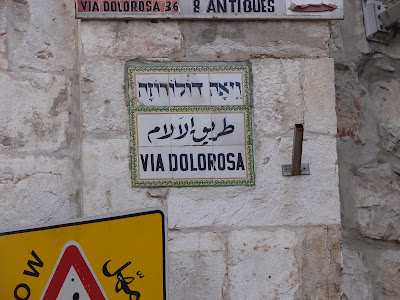Wednesday, Ashdod and Jerusalem
On Wednesday, March 11 we arrived in Ashdod. Our handout says this Mediterranean port city was a major Philistine city in ancient times, the archeological remains here have uncovered no fewer than 23 cities since the Bronze Age. Modern Ashdod was founded in 1956 and during the recent past it has had many new immigrants--70,000--mainly from the former Soviet Union, swelling the city's population to 190,000, becoming the 5th largest city in Israel. I found the port area very impressive.From Ashdod we started out for Jerusalem, a 5000 year old city revered by Jews, Christians and Muslims. I'm not sure how many buses we had (we were bus 5), but we had different routes so that we weren't all jammed up in one place. Some of us saw the Western Wall on Wednesday, some on Thursday, same with Bethlehem.

 Here we are at the Western Wall (also called Wailing Wall), the holiest of Jewish sites, a remnant of the Herodian retaining wall that once supported the Second Temple destroyed by the Romans in 70 AD. In 1967 after the Six Day War, Israelis leveled the neighboring Arab district to create the Western Wall Plaza and made the wall higher by digging down to expose two more tiers of stones buried over the centuries.
Here we are at the Western Wall (also called Wailing Wall), the holiest of Jewish sites, a remnant of the Herodian retaining wall that once supported the Second Temple destroyed by the Romans in 70 AD. In 1967 after the Six Day War, Israelis leveled the neighboring Arab district to create the Western Wall Plaza and made the wall higher by digging down to expose two more tiers of stones buried over the centuries. The men and women pray in separate sections (women need to be modestly covered); some sitting and rocking back and forth reciting the Psalms or Lamentations. This photo is of tiny pieces of paper with prayers put into the cracks in the walls. Every years thousands of people insert these prayers for peace and health, or give thanks and praise for answered prayer. If you're in my family, your name was placed there with a prayer for peace.
The men and women pray in separate sections (women need to be modestly covered); some sitting and rocking back and forth reciting the Psalms or Lamentations. This photo is of tiny pieces of paper with prayers put into the cracks in the walls. Every years thousands of people insert these prayers for peace and health, or give thanks and praise for answered prayer. If you're in my family, your name was placed there with a prayer for peace. According to tradition, The Via Dolorosa (Path of Sorrow or "Way of the Cross") is the route the Lord Jesus walked, from his trial by the Romans to his crucifixion and burial. It begins near Lions Gate (St. Stephen's Gate), in the Muslim Quarter, and ends within the Church of the Holy Sepulcher, in the heart of the Christian Quarter. This route is marked by the 14 Stations of the Cross.
According to tradition, The Via Dolorosa (Path of Sorrow or "Way of the Cross") is the route the Lord Jesus walked, from his trial by the Romans to his crucifixion and burial. It begins near Lions Gate (St. Stephen's Gate), in the Muslim Quarter, and ends within the Church of the Holy Sepulcher, in the heart of the Christian Quarter. This route is marked by the 14 Stations of the Cross.- "As they led him away, they seized Simon from Cyrene who was on his way in from the country, and put the cross on him and made him carry it behind Jesus. A large number of people followed him, including women who mourned and wailed for him. Jesus turned and said to them, "Daughters of Jerusalem, do not weep for me; weep for yourselves and for your children. (Luke 23:26-28).

 Eighth station of the cross where Jesus spoke to the women.
Eighth station of the cross where Jesus spoke to the women.






No comments:
Post a Comment